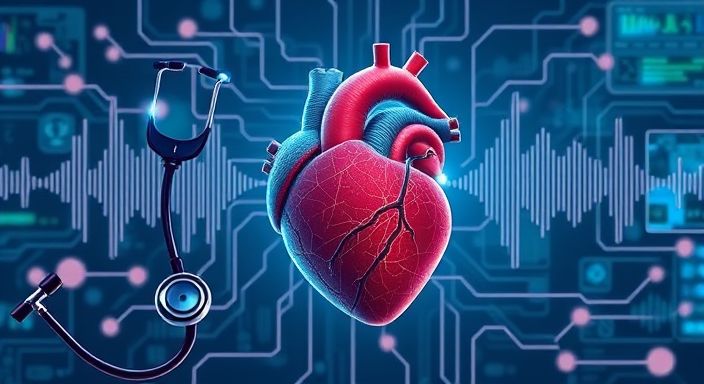In the world of medical technology, a groundbreaking development is set to change the way we diagnose heart conditions. Researchers at Columbia University have harnessed the power of large language models (LLMs) for audio to create a system that can analyze heart sounds with unprecedented accuracy. This innovative approach could soon become an invaluable tool for cardiologists worldwide, potentially saving countless lives.
The Heart of the Matter: Understanding Phonocardiograms
Cardiovascular diseases remain the leading cause of death globally, with one life lost every 33 seconds in the USA alone. Early detection is crucial, and one of the primary tools in a cardiologist's arsenal is the humble stethoscope. By listening to the heart's sounds, doctors can detect abnormalities that may indicate serious conditions.
These heart sounds, when recorded, are known as phonocardiograms (PCGs). They capture the subtle nuances of blood flow and valve activity within the heart. A key component of PCGs are heart murmurs - sounds that can signify various heart conditions.
Beyond Binary: The Complexity of Heart Murmurs
Traditionally, machine learning models focused on classifying heart sounds as either healthy or unhealthy. However, this binary approach fails to capture the rich information contained within a murmur. Experienced cardiologists evaluate several characteristics of a murmur, including:
- Timing in the cardiac cycle
- Intensity
- Location
- Duration
- Configuration
- Pitch
- Quality
Each of these features can provide crucial clues about the underlying heart condition. For instance, a high-pitched, harsh systolic murmur might indicate aortic stenosis, while a low-pitched diastolic murmur could suggest mitral stenosis.
Enter the Audio LLM: A New Frontier in Cardiac Diagnosis
The Columbia University team, led by researchers Adrian Florea, Xilin Jiang, Nima Mesgarani, and Xiaofan Jiang, has developed a system that leverages the power of audio LLMs to analyze these complex murmur characteristics. Their approach uses a state-of-the-art model called Qwen2-Audio, which has been fine-tuned on a large dataset of phonocardiograms.
Key Features of the New System:
- Comprehensive Analysis: The system can classify 11 expert-labeled murmur features, providing a much more detailed picture than previous models.
- Noise Robustness: By incorporating a preprocessing segmentation algorithm using an audio representation model called SSAMBA, the system achieves greater resilience to background noise.
- Superior Performance: The LLM-based model outperforms existing methods in 8 out of 11 features and performs comparably in the remaining 3.
- Long-tail Feature Classification: Perhaps most impressively, the system can successfully classify rare murmur features that have limited training data - a task that has stumped previous methods.
The Technical Breakdown: How It Works
The system combines two powerful components:
- PCG Segmentation Model: This front-end component uses a state-space audio representation model called SSAMBA to segment the phonocardiogram into distinct parts (S1, systole, S2, and diastole).
- Audio LLM: The Qwen2-Audio model, which contains 8.2 billion parameters, is fine-tuned to analyze the segmented PCG data.
This two-step approach allows the system to focus on the most relevant parts of the heart sound recording, leading to more accurate classifications.
Results That Speak Volumes
The team's results are nothing short of impressive. For systolic murmur features like timing, shape, pitch, and quality, the system achieved 100% accuracy when using the segmentation front-end. Even without segmentation, the accuracy remained above 99% for most features.
For diastolic features, which are typically more challenging to classify due to their rarity, the system also achieved 100% accuracy in timing, shape, pitch, and quality.
The only area where the system struggled was in grading murmurs (classifying their intensity on a scale of I to VI). This limitation is likely due to the model's difficulty in interpreting Roman numerals, as the text encoder was frozen during fine-tuning.
The Future of Cardiac Care
While this technology is not meant to replace human cardiologists, it has the potential to become an invaluable assistant. By providing rapid, detailed analysis of heart sounds, it could help doctors:
- Screen patients more efficiently
- Detect subtle abnormalities that might be missed by ear alone
- Standardize murmur classification across different healthcare providers
- Provide a second opinion in challenging cases
As with any medical technology, further clinical validation will be necessary before this system can be widely adopted. However, the potential for improving cardiac care is enormous.
Conclusion: A Heartbeat Away from Revolution
The integration of audio AI into cardiology represents a significant leap forward in our ability to diagnose and treat heart conditions. By combining the pattern recognition capabilities of large language models with the nuanced understanding of heart sounds, we're opening up new possibilities for early detection and precise diagnosis of cardiovascular diseases.
As this technology continues to evolve, we may soon see a world where every stethoscope is backed by the power of AI, helping doctors make more informed decisions and ultimately saving more lives. The future of cardiology is not just about listening to the heart - it's about understanding its every whisper.
